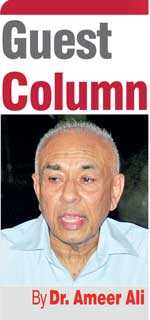Monday Mar 17, 2025
Monday Mar 17, 2025
Monday, 14 January 2019 00:04 - - {{hitsCtrl.values.hits}}

“Don’t let anyone break your wings, you are free, fight and get your RIGHTS,” were the words tweeted by the 18-year-old apostate, Rahaf Mohammed al-Qunun from Saudi Arabia, who renounced Islam, ran away from her family and sought asylum in a foreign country.
UNHCR recognised her as a refugee and Canada welcomed her. The Saudi Government washed its hands off from any responsibility and treated the matter as a family issue. A regime that is already reeling under international pressure calling for justice over the brutal murder of journalist Jamal Khashoggi is understandably keeping its distance from the whole affair.
However, is the Saudi regime totally blameless? Is the regime not in collusion with the most ultra-conservative religious ideology, Wahhabi Salafism, which is making life oppressive for women in that country?
For decades, if not centuries, women in that kingdom have been crying to be freed from the suffocating rigidities of a religious orthodoxy that is depriving them of their God-given dignity and human right? The reality is that in Wahhabi Salafism Saudi Monarchy finds a powerful weapon to keep its people under submission. To relax the grip of Wahhabi Salafism is to invite danger for the survival of the regime itself.
Rahaf, in her tweeted message, added further that she was ill-treated by her family for cutting her hair short and was locked up in a room for six months. She is now fearing for her life, because she has renounced Islam and become an apostate for which Shariah prescribes death as punishment.
Her father, in an interview to authorities in Thailand, said that she is one of his 10 children and admitted without elaboration that she may have felt “neglected” at times. If family abuse was the main grievance, the girl could have just run away without renouncing Islam. Why did she renounce both?
Oppressive nature of religious orthodoxy
About three decades ago, while I was chatting in Perth, Australia, with the late Egyptian born Dr. El-Irian, an internationally-recognised scholar in cultural studies, a humanist and a former President of the Australian Federation of Islamic Councils, on Muslim affairs, he said with great regret and concern that “orthodoxy has made Islam unliveable for the young and many are running away from it”. Rahaf’s escape and apostasy has provided the latest factual proof to El-Irian’s statement. What follows is a short exposition of the oppressive nature of religious orthodoxy focusing mainly on Wahhabi Salafism.
While European Enlightenment in the 16th century gave birth to modernity, intellectual rationalism and scientific theories, post-modernism in the 20th century revolted against all structured theories of its predecessor and produced in turn a new era that challenged even the rationalist assumptions of modernism. Post-modernism marks the beginning of an age of endless revolt against all received wisdom and relentless search to discover and experiment new responses and solutions to problems confronting every branch of human life. The questions why and why not are the driving forces behind this ceaseless quest and they are dismantling age-old fortresses of wisdom built on spiritual foundations.
However, this ceaseless quest has hit a brick wall in the Muslim world, particularly where Muslims live in majority and where religious orthodoxy and orthopraxy have strangle hold over the believers thought and actions.
The Wahhabi Salafi package is an all-or-nothing offer. No question about the contents of the package is tolerated and no suggestion for repackaging is entertained. Nevertheless, the walls of Salafi orthodoxy are beginning to crack. The internet and social media have opened the flood gates for internal challenges. While questions are now being asked and suggestions for change are pushed from within the Salafi stronghold itself, by a group of “Muted Modernists”, as Medawi al-Rasheed, the Saudi Arabia born scholar calls them, an 18-year-old girl has decided to reject the entire package and caught the world’s attention. To this youngster, Salafi orthodoxy with its orthopraxy and her own family schooled in that oppressive environment have become intolerable, and hence her decision to become an apostate. She is not the first woman to do so however, nor will be the last
Logically speaking, modernism and its post-modern prodigy should have started in the world of Islam had the rationalist movement that sprouted in the 9th and blossomed till the end of 11th centuries been allowed to grow unchallenged and pushed to the brink of extinction by a state backed religious orthodoxy based on narrow scriptural readings. This orthodoxy since then had become the handmaiden of Muslim autocrats and oppressive regimes in their determination to keep in submission people whom they rule. Saudi Arabia is a classic example of this diabolic partnership between autocracy and religious orthodoxy cum orthopraxy.
Moreover, after the Second World War and during the Cold War, US superpower with its European allies found this partnership particularly handy in designing a new Middle East Order. Thus, Saudi Arabia with her petroleum resources is uniquely protected from the intrusion of any post-modern tendencies. Any sign of such tendency is nipped in the bud either through monetary bribe or bloodshed. What happened there in the aftermath of the Arab Spring is proof of this. Yet, as will be shown later, this protection is crumbling through the floodgates of a digital age.
A mosaic of differentiated ideologies
Islamic religious orthodoxy, like Islam itself, is not a monolith. It is a mosaic of differentiated ideologies founded by leaders of different nationalities and cultures with different objectives and methodologies. They also differ in respect of their degree of tolerance towards alternative views and critical thought. Within this mosaic however, the Wahhabi brand of Salafi orthodoxy born in Saudi Arabia is perhaps the most rigid and ultraconservative.
Although the eponymous Wahhabism began in 18th century and founded by preacher Muhammad Ibn Abdul Wahhab, and gained ascendancy and permanency through his political alliance with the tribal chief Muhammad bin Saud, its religious philosophy has a long genealogy traceable to the ideas of one of the four famous imams in Sunni Islam, Ahmad ibn Hanbal (780-855).
Of the four Sunni schools of thought Hanbalism is the most rigid. Wahhabi Salafism with its orthopraxy is a distinct package of dos and don’ts, administered through a state backed religious bureaucracy and institutions that is suffocating the ordinary life of many of the kingdom’s subjects, particularly that of the womenfolk. How this is can be demonstrated by few examples.
In 2002, when Girls’ School No. 31 caught fire in Mecca, 15 of its young students perished in that fire, only because the mutawween or religious police refused to allow those girls escape, because they were “not properly covered”. To this police, a piece of cloth was more sacrosanct than 15 bubbling human lives.
No woman in that country can step out of her house alone unless accompanied by a relative male. Even then, she should be properly covered from head to toe. Driving by women was prohibited, which led to the ‘Women2Drive’ protest movement by some daring females. They were arrested and thrown into jail. Some of them are reported still languishing in prison even though prohibition has been removed recently, by the so-called modernist Crown Prince Muhammad bin Salman, who is alleged to have masterminded the murder of journalist Jamal Khashoggi.
To apply for a driving licence a woman has to first get permission from her husband or father. Gender mixing even in offices is strictly prohibited. Men are permitted to have multiple wives and concubines, but women cannot have multiple husbands or boyfriends. In short, women in Saudi Arabia are virtually second class citizens.
Wahhabi Salafi package is an all-or-nothing offer
The Wahhabi Salafi package is an all-or-nothing offer. No question about the contents of the package is tolerated and no suggestion for repackaging is entertained. Nevertheless, the walls of Salafi orthodoxy are beginning to crack. The internet and social media have opened the flood gates for internal challenges.
While questions are now being asked and suggestions for change are pushed from within the Salafi stronghold itself, by a group of “Muted Modernists”, as Medawi al-Rasheed, the Saudi Arabia born scholar calls them, an 18-year-old girl has decided to reject the entire package and caught the world’s attention.
To this youngster, Salafi orthodoxy with its orthopraxy and her own family schooled in that oppressive environment have become intolerable, and hence her decision to become an apostate. She is not the first woman to do so however, nor will be the last.
Clash between tradition and post-modernity
There is an observable tension within the world of Islam between the champions of religious orthodoxy based on mytho-historical mindset and a growing generation of young men and women equipped with a post-modernist techno-scientific mindset. There is, in other words, a clash between tradition and post-modernity.
The whys and why nots that the new generation is asking cannot be satisfactorily answered with quotations from past wisdom and examples from past generations. Without the power of reasoning and logic and without tolerance for alternate views and approaches religious leaders cannot guide the new generation.
It is this glaring g failure by orthodoxy that prompted El-Irian to make that statement and the young girl to become an apostate. The challenge is not only for Saudi Arabia but also by inference to all other shades of religious orthodoxies that are trying to close the flood gates of reason and logic.
(The writer is attached to the School of Business and Governance, Murdoch University, Western Australia.)
Discover Kapruka, the leading online shopping platform in Sri Lanka, where you can conveniently send Gifts and Flowers to your loved ones for any event including Valentine ’s Day. Explore a wide range of popular Shopping Categories on Kapruka, including Toys, Groceries, Electronics, Birthday Cakes, Fruits, Chocolates, Flower Bouquets, Clothing, Watches, Lingerie, Gift Sets and Jewellery. Also if you’re interested in selling with Kapruka, Partner Central by Kapruka is the best solution to start with. Moreover, through Kapruka Global Shop, you can also enjoy the convenience of purchasing products from renowned platforms like Amazon and eBay and have them delivered to Sri Lanka.
Discover Kapruka, the leading online shopping platform in Sri Lanka, where you can conveniently send Gifts and Flowers to your loved ones for any event including Valentine ’s Day. Explore a wide range of popular Shopping Categories on Kapruka, including Toys, Groceries, Electronics, Birthday Cakes, Fruits, Chocolates, Flower Bouquets, Clothing, Watches, Lingerie, Gift Sets and Jewellery. Also if you’re interested in selling with Kapruka, Partner Central by Kapruka is the best solution to start with. Moreover, through Kapruka Global Shop, you can also enjoy the convenience of purchasing products from renowned platforms like Amazon and eBay and have them delivered to Sri Lanka.